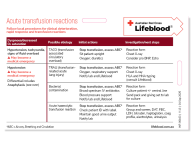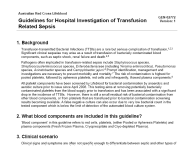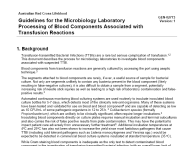Don’t have an account?
Select the donation type you’d like to make
Bacterial contamination of blood component (primarily platelets) continue to cause morbidity and fatalities. The source of bacteria is generally the donor’s skin but can also be due to an underlying asymptomatic bacterial infection in the donor.
Any bacteria in the donation can multiply during storage especially in platelets which are stored at room temperature. Although reactions due to bacterially contaminated red cells are less common because refrigerated storage slows growth there are rare cases due to organisms such as Yersinia enterocolitica which are capable of proliferating in the cold.
When to suspect this adverse reaction
Clinical features suggesting the possibility of bacterial contamination and/or endotoxin reaction may include rigors, high fever, severe chills, hypotension, tachycardia, nausea and vomiting, dyspnoea, or circulatory collapse during or soon after transfusion.
In severe cases, the patient may develop shock with accompanying renal failure and disseminated intravascular coagulation (DIC).
These reactions may be fatal.
In Australia, clinically apparent reactions due to bacterial infections are reported in approximately 1:250,000 platelet transfusions and approximately 1:2.5 million red cell transfusions.
Bacterial infection is more common with:
- platelets (as these are stored at room temperature)
- previously frozen components thawed by immersion in a water bath, and
- red cell components stored for several weeks.
Usual causes
Blood components may be contaminated by:
- bacteria from the donor’s skin during the collection procedure
- unrecognised bacteraemia in the donor
- contamination from the environment
- contamination during the preparation of components, and
- contamination of ports during the thawing of frozen products in a water bath.
Both gram-positive and gram-negative organisms have been implicated in transfusion-transmitted bacterial infection with serious morbidity and mortality occurring most frequently with gram-negative bacteria.
Organisms capable of multiplying at low temperatures and those using iron as a nutrient are most often associated with red cell contamination, especially Yersinia enterocolitica.
Investigation
Request for blood cultures from the patient, and perform culture and Gram Stain on the remainder of the blood component.
The key to diagnosing transfusion-related sepsis is culturing the same organism from the patient and component.
Keep the blood bag and giving set (sealed) for further investigation.
For further information on hospital investigations refer to our 'Guidelines for hospital investigation of transfusion related sepsis' and 'Guidelines for the microbiology laboratory processing of blood components associated with transfusion reactions'.
What to do
Stop the transfusion immediately and follow other steps for managing suspected transfusion reactions.
Seek urgent medical assistance as this may become an emergency.
Start broad-spectrum antibiotics once cultures have been taken.
Provide cardiorespiratory support.
Send blood pack to the Transfusion Service Provider for urgent culture and Gram Stain.
Advise Transfusion Service Provider to notify Lifeblood to ensure quarantine and testing of related components from the same donation/donor.





